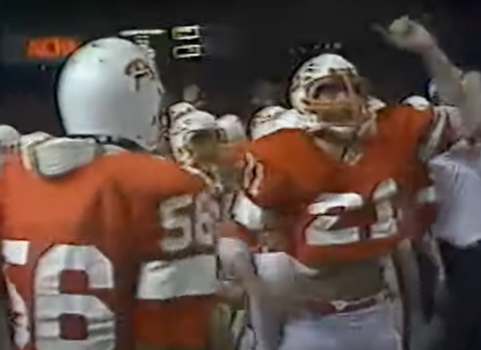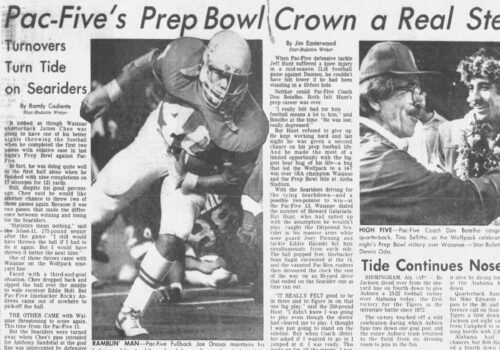Football players are knocked down all the time and they get up.
After receiving some incredibly bad news recently, the PAC-5 football team has figuratively hit the ground. But can the Wolfpack coaches, administrators and players stand up and gain solid footing?
PAC-5 athletic director Peter Estomago and the coaches are hopeful, but they know it won’t be easy to keep football going. That’s because one of the feeder schools to the program, Mid-Pacific Institute, announced earlier this month that it will not continue on as part of PAC-5.
Aside from losing a large percentage of its players in the form of MPI’s Owls, the Wolfpack will no longer be practicing at the Mid-Pacific field, the place they have operated out of since the start of PAC-5 football in the early 1970s.
“Mid-Pacific’s decision is a big loss for us,” Estomago said. “They were one of the founding schools in the 1970s.
“Now our homework begins. We are in the process of securing facilities, but we haven’t nailed down a field and we are definitely going to need storage. Another obstacle is the financial end. Small schools don’t have the deep pockets of some of the larger schools in the ILH.”
Fullback Joe Onosai, coach Don Botelho and quarterback Tino Sellito were pictured in the next day’s newspaper after winning the 1982 Prep Bowl. (Honolulu Star-Bulletin clipping from Newspapers.com).
Students from 15 small schools make up PAC-5, which participates in many of Hawaii’s high school sports. Football players, however, are coming from only 10 of those schools.
“It’s imperative that, if our schools want this to continue, we get out and contact the student-athletes and see who is interested in growing PAC-5 football and get an idea of what our numbers could be,” Estomago said.
For PAC-5 football, things started at the JV level in 1971, when the program was called the HUMMERS (featuring players from Hawaii Baptist, University Lab School, Maryknoll and Mid-Pacific). In 1974, the program added varsity ball, with Our Redeemer Lutheran joining in and coach Don Botelho coming over from Damien.
Recently, Estomago held a meeting with participating schools’ athletic directors and current varsity coach Kip Botelho (Don’s son and a former PAC-5 player) and his staff.
“Everybody is very enthusiastic about keeping it going,” Estomago said.

Over the next few years, it’s likely that a huge, arduous dogfight will ensue to keep things HUMMING at the intermediate and varsity levels.
“The numbers of players coming over from Mid-Pacific have been big,” Estomago said. “They made up about half of our intermediate team (in 2019).”
In terms of numbers, the goal for PAC-5’s football program is to suit up 50 varsity and 50 JV players. By Interscholastic League of Honolulu rule, all teams must have 30 players in full uniform for each game.
Reaching that lower number of 30 has been a struggle for PAC-5 through the years — even with Mid-Pacific players coming in bunches.
The Wolfpack Want To Build On 2019’s 6-3 Record
For PAC-5, the timing of Mid-Pacific’s decision is unfortunate. The Wolfpack are coming off a highly successful 6-3 season in 2019 (no season was held in 2020) that was partly made possible by the increased competition due to the ILH’s alliance with the OIA.
“That agreement with the OIA really helped out with our scheduling and many other ways” Estomago said. “And that winning record was really a blessing for our program. But it was also a hard thing when we couldn’t qualify for states.”
A Hawaii High School Athletic Association rule requires the state’s five leagues to have at least two squads participating at a certain level to have a representative in the postseason, and the Wolfpack were the only ILH D-II ILH team that year.
If Pac-Five winds up folding, which is the worst-case scenario, it would also be a major loss to the ILH, which — before the agreement with the OIA — struggled mightily just to have a full schedule of games. No PAC-5 squad would mean only five teams in the private school league.
—
ALSO AT BedrockSportsHawaii.com:
>> RIVALS WAIKIKI BASEBALL GAME OF THE WEEK: Saint Louis Jets Into First-Place Tie With Kamehameha
>> ‘Iolani Baseball Team Pulls A Fast One In Victory Over Dunn Muramaru’s Mid-Pacific Owls
>> Kaiser’s Kyler Halvorsen Accepts Washington State Football Team’s Invitation To Be A Preferred Walk-On
—
Estomago wants to keep fighting to give those kids who don’t attend a school that offers football a chance to participate in the sport.
“There are a lot of people out there who understand that they wouldn’t have been able to play football in high school if it wasn’t for our program,” he said, before mentioning many former Wolfpack players who went on to star at higher levels like former UH star quarterback Garrett Gabriel, former Dallas Cowboys draft pick Joe Onosai, and former Cleveland Browns, New England Patriots and New Orleans Saints defensive tackle Pio Sagapolutele. “They know. It means a lot to them to have had the chance to play.”

over Waianae at Aloha Stadium. (Screenshot of a You Tube video).
In recent years, Pac-Five has typically been at the lower end of the standings, but the Wolfpack have also had some incredibly successful seasons, including championships in the Oahu Prep Bowl (the forerunner to the state tournament) in 1982 and 1985 under Botelho.


